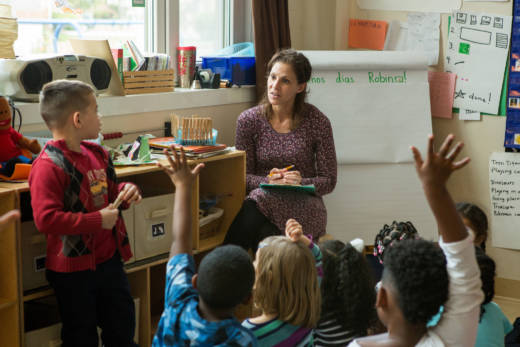You can download the data yourself. Please let us know what you find at baycurious@kqed.org.
The Good News: The Odds Are in Your Favor
We found that the majority of students, 61 percent, enrolled in their first-choice school, 77 percent enrolled in one of their top five choices and 80 percent in one of their top 10 choices.
Many parents said that one of their big fears was being assigned a random school, one they didn’t list. However, only 3 percent of children received a random school in the first round of assignments.
Gaming Techniques
While 80 percent is a pretty good chance, it does mean that a fifth of students will not get one of their top 10 choices. There’s a lot of advice out there from parents, organizations and the school district on how to ensure your kid will get into the right school for you. We analyzed some of the most popular techniques to see how they stood up.
Note: Each school year is different, and the school district does sometimes tweak the algorithm based on school board policies. So these findings apply to students who applied for the 2017-2018 school year.
Listing a Lot of Schools
There’s a lot of playground chatter, as well as online blogs, saying that listing a lot of schools is one way to success. The vast majority of people list 10 schools or less, about 75 percent.
However, some people listed far more schools than 10. Several even listed more schools than are available to attend, up to 92. But we found this system doesn’t necessarily improve the odds of enrolling in one of your top-choice schools.
We found that, of people who listed more than 10 schools, 39 percent received their first choice, 62 percent received one of their top five choices and 67 percent received one of their top 10 choices.
Laurel Gaddie’s son, Kelvin, goes to Sanchez Elementary School; her daughter will be entering the lottery this year. When applying to kindergarten for Kelvin, Gaddie listed a lot of schools based on advice from parent blogs.
“When I first looked at our list of 17 [schools] I thought, this is absurd, but hopefully it will result in us getting our top choice. It didn’t,” Gaddie says.
KQED asked the San Francisco Unified School District about our findings. However, it did not respond to our requests.
Listing the Same School Multiple Times
We also found that many parents listed the same school several times in their lottery applications. However, this technique did not appear to have any significant impact either way on how likely those students were to enroll in their top choices.
Listing Schools for Swapping
Before everyone receives their first-round school assignment, the algorithm “swaps” schools. Basically, the algorithm looks out across all the tentatively assigned students to see if any two could both receive a higher ranked choice if they swapped places. Then the algorithm transfers the two assignments, so Student A gets Student B’s assignment and vice versa. The district says 10 percent of first-round assignments were affected by the swapping mechanism in 2017-18.
This has led some parents to list schools that they think other parents may want in hopes that, during the swapping phase, they could get one of their higher choices.
“The strategy is, you fill out your top 10 schools and then you put all the other schools, even if of course you’re not going to go there,” said Jenny Williams, a parent who just went through the school assignment process. “You get the extra piece of paper and you put them all on there. Every school — which is ridiculous.”
Williams didn’t use this strategy, but she heard plenty about it from other parents as she went through the process.
KQED could not tell from the data provided whether this technique is effective. However, the school district is considering dropping the swapping mechanism.
“We’re concerned that it’s complicated and difficult to understand, and that it encourages families to list schools they don’t want as a strategy to get a choice,” says Orla O’Keeffe, executive director of policy and operations for the SFUSD.
Neighborhood Schools
One factor we know the algorithm considers is whether the child lives in the school’s attendance area. This has left parents wondering where they should rank the schools closest to them. The data we received does not show how requests are weighted by the system. However, a majority of students enrolled in schools out of their ZIP codes.
We did find that some ZIP codes seem harder to leave than others. Students in areas like the Outer Richmond are more likely to attend schools in their ZIP codes.
Most Requested Schools
The top 10 most requested schools, in order:
- Clarendon Elementary School
- West Portal Elementary School
- Grattan Elementary School
- Rooftop Elementary School
- Lawton Alternative School
- Sunset Elementary School
- George Peabody Elementary School
- Claire B. Lilienthal Elementary School
- Alvarado Elementary School
- Jefferson Elementary School
School by School
Below you can select different schools to see how they compare in terms of applicants and enrollees.
About 4,611 children entered the 2017-2018 San Francisco Unified School District kindergarten lottery. Parents can select multiple schools, and they made more than 45,000 unique choices. So, while some of the application numbers may seem incredibly high, keep in mind that there are a lot of applications, compared to enrollments.
Also, not every child who enters the lottery enrolls. While there are 4,611 students represented in the lottery, 4,043 had enrolled as of Nov. 3, 2017 in a San Francisco public school.
Note: We removed duplicate entries from school requests for this graphic.
Methodology: See our work on GitHub.
